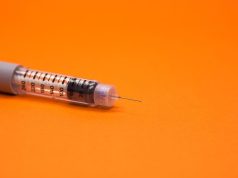Most commonly reported adverse drug reactions were respiratory disorders
TUESDAY, Jan. 26, 2016 (HealthDay News) — For children with infantile hemangiomas, severe adverse drug reactions (ADRs) are rare with propranolol treatment, according to a research letter published in the Jan. 26 issue of the Journal of the American Medical Association.
Sorilla Prey, M.D., from the Université de Bordeaux in France, and colleagues examined ADRs in children with proliferative infantile hemangioma. Overall, 922 patients were referred and 906 (median age, 114 days) were treated with propranolol.
The researchers found that indications for treatment included functional impairment, severe ulceration, and life-threatening conditions (72.4, 40.0, and 16.2 percent, respectively). Propranolol was administered for a median duration of 198 days; patients were followed for a median of 396 days. Of the 313 children who stopped propranolol, 5.8 percent stopped for ADRs. Overall, 8.8 percent of the 922 patients had 133 ADRs, including 2.6 percent with 36 serious ADRs. The most commonly reported ADRs were respiratory disorders (reported in 31 patients; serious ADRs related to propranolol in six patients). Cardiac and metabolic disorders were the most serious ADRs; four patients had cardiac ADRs, of which two were related to propranolol.
“This large prospective cohort study found that serious ADRs were rare when propranolol was used to treat severe infantile hemangiomas, confirming two smaller studies,” the authors write.
Two authors were investigators in clinical trials evaluating propranolol in infantile hemangioma promoted by the Pierre Fabre Dermatologie pharmaceutical company, which supported the current study. The company developed and provided the oral pediatric specific formulation of propranolol chlorhydrate.
Full Text (subscription or payment may be required)
Copyright © 2016 HealthDay. All rights reserved.








